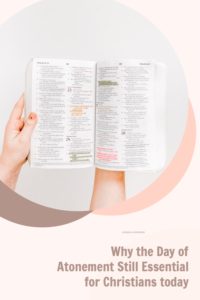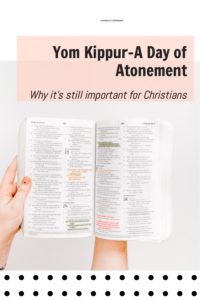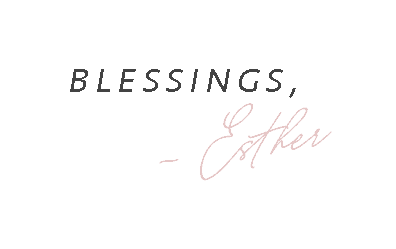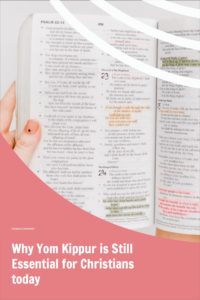Every year, Jews worldwide celebrate Yom Kippur or the Day of Atonement. Repentance. Confession. Humility. These three heart postures envelop the holiest day of the Jewish year. During this second fall festival (Yom Teruah or Rosh Hashanah is the first), the Creator of heaven and earth judged the nation’s sins, cleansing them from unrighteousness. While Israel reflected on their sins and spent time in prayer and fasting, this somber occasion was, in fact, a day of joy and hope.
Be sure to download the free workbook “Understanding the Biblical Feast” in the freebrary.
What Does Yom Kippur or Day of Atonement Mean?
Yom is the Hebrew word for “day.” The term “atonement” comes from the Hebrew word כָּפַר kāp̄ar, meaning, “to cover, to cover over, purge, make reconciliation, pacify, propitiate, atone for sin, to cover with pitch.” Interestingly, this is the same word used when God told Noah to make an ark of wood and “cover it with pitch,” thereby covering Noah through the flood. The mercy seat (more below) located in the Holy Place also comes from this root word, meaning the place of propitiation.
When is the Day of Atonement?
Remembering a yom (day) runs from sundown to sundown, Yom Kippur began at sundown on the tenth day of the seventh month, Tishri, corresponding with our mid-September to mid-October. The preceding ten days were the Days of Awe, which began on Yom Teruah or Rosh Hashanah. (Leviticus 16:29; Leviticus 23:27; Numbers 29:7)
2022 – Sundown October 4th – 5th
2023 – Sundown September 24th – 25th
2024 – Sundown October 11th – 12th
For Who or what was the Day of Atonement?
Yom Kippur was how God and the people of Israel were reconciled; it was the day of covering or ransom. In Leviticus 16, we see that atonement was made to purify:
- The high priest and his household. The first cleansing atonement was for the high priest so he could continue to serve as a mediator between God and his people.
- The Holy Place. Within the Holy Place was the mercy seat–God’s “throne” on earth. Here the presence of God met with Moses (Exodus 25:17-22). Only on Yom Kippur was the high priest allowed to enter beyond the veil.
- Tent of meeting. Because the tent of meeting dwelt among the peoples’ transgressions and sins, it had to be cleansed and consecrated.
- The altar dwelt amidst their sin and was where sacrifices were made throughout the year.
- All the people of Israel. This day was to be an everlasting statute that once a year, atonement was made for their sins.

Jewish belief on the Day of Atonement
According to Jewish tradition, God judges each person according to their deeds on this day, deciding whether they will be inscribed in the Book of Life for another year or blotted out. Furthermore, the Jews believe the final judgment will come on the Day of Atonement, where the opportunity for repentance is closed, setting the soul’s fate.
Summary of the Day of Atonement in the Bible
- This day began with fasting and a sabbath day of rest in which no occupational work was done among the nation.
- The high priest had to bathe and put on the holy garments.
- Take one bull from the herd for his sin offering.
- Choose two spotless male goats for the sin offering and one ram for the burnt offering from the congregation.
- Set the two spotless male goats before the Lord at the tent of meeting.
- The priest had to cast lots between two goats. One would become the sacrificial goat, and the other would become the scapegoat.
- High priest enters behind the veil to make atonement for the Holy Place and tent of meeting:
- He offers the bull as his and his family’s atonement offering, sprinkling some of its blood on the mercy seat within the Holy Place seven times.
- Offer the chosen goat for the congregation’s sins, sprinkling some of its blood on the mercy seat seven times.
- Then, he makes atonement for the altar by taking some blood from the bull and goat and sprinkling the altar seven times.
- Presenting the live scapegoat before the Lord, the high priest would lay both hands on the scapegoat’s head and confess over it all the iniquities, transgressions, and sins of the people. These would be “placed upon its head.”
- The people’s sins were thus transferred to the scapegoat who bore their iniquities. The scapegoat is now led away into the wilderness, where it would be set free and never seen again.
- The high priest is now to go into the tent of meeting, take off the holy garments, bathe in water within a sacred place, and put back on his clothing.
- He now exits the tent of meeting to administer the burnt offering (ram) on the altar.
- The bull and the goat used for sprinkling the blood atonement are carried outside the camp and burned.
- All involved in leading the goat into the wilderness and carrying the bull and goat outside the camp must also bathe before reentering.
Why Was Blood Required for the Sacrifice of Sins on the Day of Atonement?
One of the most critical aspects of this cleansing process was blood sacrifice. But why was blood required? In the Old Testament, the book of Leviticus lays out the requirements for the Day of Atonement. On this day, the high priest would enter the Holy of Holies (Holy Place), where only he was allowed to go. He would sprinkle blood on the mercy seat, which covered the Ark of the Covenant. The Ark not only contained the Ten Commandments but also represented God’s presence among his people.
The sprinkled blood signified that something had died in place of the person who sinned. In other words, it was a substitute sacrifice. The first time we see substitution is in Genesis 3 when, after rebelling against God, Adam and Eve attempt to make a covering out of fig leaves. In verse 21, we read about the first death of an animal when God made garments of skin–a covering for their sin.
Fast forward to Leviticus 17, and God tells Israel:
- The life of every creature is in its blood.
- God has given it (blood) to us for the altar.
- The blood makes atonement for our souls.
- Without the shedding of blood, there is no atonement.
From the beginning, this sacrificial system foreshadowed Jesus Christ. While this imperfect system would “cover” the peoples’ sins until the subsequent atonement, it did not “remove” them.
How does Jesus fulfill this blood requirement?
All the meaning of Leviticus and the fulfillment of this day converge in the book of Hebrews. According to Hebrews 9:22, without the shedding of blood, there is no forgiveness. The Old Testament prescribed animal sacrifices to deal with sin. However, these sacrifices were only a temporary fix. They did not deal with the root problem, which was a sinful heart.
Jesus, who lived a spotless life, gave His lifeblood on the Cross for permanent forgiveness of our sins and to cleanse our souls. Because of His sacrifice, we no longer need to offer animals as sacrifices for our sins. We now have an eternal relationship with God. Our hearts are forever cleansed and changed.
“For if the blood of goats and bulls and the ashes of a heifer sprinkling those who have been defiled sanctify for the cleansing of the flesh, how much more will the blood of Christ, who through the eternal Spirit offered Himself without blemish to God, cleanse your conscience from dead works to serve the living God?” Hebrew 9:13-14
Without Jesus shedding His blood, we would have no cleansing, no covering for our sins–no kāp̄ar.
While this substitution may be a stumbling block for some and foolishness to others (1 Corinthians 1:18-24), it is how God determined it would be. These atoning threads are interwoven into Scripture from beginning to end.

How the sacrificial and scapegoat both point to Jesus.
Isaiah 53 meticulously foretells the suffering Messiah who would be pierced for our transgression, crushed for our iniquity, and bear our sins. While the sacrificial goat represented the sins of Israel being forgiven, the scapegoat signified that their sins had been removed from them.
Upon our spotless Scapegoat, the Lord laid the iniquity of us all. Through His outstretched arms of sacrifice, our sins are not only forgiven but also removed as far as the east is from the west (1 John 1:7; Hebrews 10:10; Psalm 103:12). Though our sins were once scarlet, they are now as white as snow (Isaiah 1:18). By His wounds alone, we are counted as righteous. We have peace with God (Colossians 11:20).
Jesus is now our High Priest.
While the priest represented and intervened on behalf of the people by the blood of animals, Jesus became our eternal High Priest through His own shed blood, now living to make intercession for us. Hebrews 7:22-25, 9:11-12
Only once a year could the priest enter the Most Holy Place to make atonement for the sins of Israel upon the mercy seat. Jesus, our High Priest, has once and for all entered the Most Holy Place and is seated at the right hand of God. Hebrews 9:11-12, 24-26; Hebrews 10:12
Because of Jesus’ perfect sacrifice, the veil/curtain that once separated sinful mankind from God (Holy Place) has been removed. Through Christ, we now have access to the Father. Instead of having a human mediator (priest), we can come boldly before God’s throne and receive His grace and mercy. Hebrews 4:16; Hebrews 10:19-22, Ephesians 2:18, Matthew 27:50-51; 1 Timothy 2:5
Why is the Day of Atonement Still Essential?
The Day of Atonement is a momentous day in Christianity because it points us to Jesus Christ and what he did for us on the cross. His sacrificial death cleansed us from all unrighteousness and brought us back into a relationship with God. It serves as a powerful reminder of how much we need Jesus as our Savior–not just on this holy day but every day of our lives.
As we contemplate today, let us come to Him with repentant hearts, confessing our sins and humbly accepting His forgiveness. Let us remember those who do not yet know Him so that they, too, might experience His grace and love.


